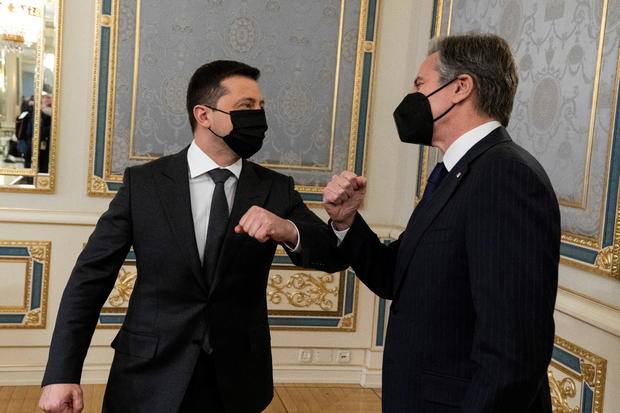Moscow — The Biden administration announced an additional $200 million in military aid for Ukraine on Wednesday, bolstering U.S. support for the country amid fears of a potential Russian invasion.
“We are committed to Ukraine’s sovereignty and territorial integrity and will continue to provide Ukraine the support it needs,” a U.S. State Department official told reporters traveling with Secretary of State Antony Blinken, as he headed to Ukraine’s capital city.
Blinken was in Kyiv on Wednesday to meet Ukrainian President Volodymyr Zelenskyy and Foreign Minister Dmytro Kuleba. The visit came as Washington and its European allies stepped up their warnings to Russia that any assault on Ukraine would bring “massive consequences.”
“Aggressive action,” or a “peaceful path”
Russia has already massed more than 100,000 troops along its border with Ukraine. In Kyiv, Blinken said he hoped Russia would continue diplomacy and remain on a “peaceful path,” but he said Moscow appeared poised for “aggressive action.”
“We know that there are plans in place to increase that [Russian] force even more on very short notice, and that gives President Putin the capacity, also on very short notice, to take further aggressive action against Ukraine,” he told diplomats at the U.S. Embassy in Ukraine’s capital on Wednesday. “I strongly, strongly hope that we can keep this on a diplomatic and peaceful path, but ultimately, that’s going to be President Putin’s decision.”
Blinken is scheduled to meet his Russian counterpart, Foreign Minister Sergey Lavrov, in Geneva on Friday.
President Zelenskyy extended his thanks to America on Wednesday for its backing.
“I would like to thank you personally,” he told Blinken, “and President Biden and the U.S. administration, for your support, for military assistance to Ukraine, for increasing this assistance.”
POOL/REUTERS
“We understand that to take steps quickly to modernize the army, we need help, especially in these… difficult times,” the Ukrainian leader said.
Russia’s demands
Talks last week between U.S., NATO and Russian officials failed to bridge stark disagreements over how to resolve the standoff along the Ukraine-Russia border.
Moscow has issued a number of security demands, the main one being that NATO rule out admitting new members along Russia’s western flank — including a guarantee that Ukraine will never join the alliance. U.S. officials have ruled out any such commitment, insisting that only NATO will decide which nations to welcome as members.
The American side said it was prepared to discuss certain security matters, such as military exercises and deployments in the region, but Russia has shown no inclination to let the U.S. pick and choose the topics of future negotiations.
U.S. officials have said they’re not sure whether Putin has made a decision to invade Ukraine, or whether the saber-rattling is just aimed at extracting security commitments from the West, without an outright conflict.
False-flag fears
As CBS News senior foreign correspondent Holly Williams reports, Washington has voiced concern that Russia could launch a so-called false-flag operation — a staged incident that it uses as a pretext for an invasion. Those fears were only compounded by Russia’s announcement on Tuesday that it will send forces into Belarus next month for joint military exercises with its ally.
Russia considers NATO’s presence in the region, and certainly any moves to bolster it, a threat. But Williams, who’s made multiple trips to the front line in eastern Ukraine in recent months, says many people in that country believe Putin is playing a Cold War-style game of brinkmanship, trying to extract concessions from America and its allies — and they worry it could escalate quickly.
Williams visited one of the dozens of Cold War-era bunkers across Ukraine that have been renovated and reopened after decades – this time to protect civilians not from the potential American attacks they were designed for, but from Russian weapons.
Russia’s mixed signals
Russia continues to send mixed signals, insisting it has no plans or intentions of attacking Ukraine, but warning that it will resort to “military-technical” means if talks with the U.S. fail. It has brushed off calls to withdraw its troops from the border region, saying it’s free to move forces around as it pleases on its own territory.
“I am sure that there is no risk of a large-scale war that could unfold in Europe or anywhere else. We do not intend to take any aggressive action,” senior Russian diplomat Sergey Ryabkov, who has led the negotiations with the U.S., said on Wednesday. “We do not intend to attack or invade Ukraine.”
He added that Moscow was still waiting for a written response from NATO to Russia’s security demands.
“As the Russian side has repeatedly emphasized, the issue is urgent, we are not ready to wait indefinitely, we are not ready to plunge into the usual diplomatic, bureaucratic mess about what formats are optimal for this. We need a direct and understandable answer, in writing,” he said.
U.S. and European leaders have been united in condemning Russia’s actions, but there’s less unity about how to deter Moscow.
The U.S., Britain, Canada, and Turkey have increased military assistance, sending experts, anti-tank missiles and armed drones, and helping Ukraine rebuild its Navy, among other things. Europe’s biggest economy, however, Germany, appears to be treading more cautiously, declining to provide direct military aid.
Russia, meanwhile, has been keen to show strong relations with its own allies, including with the announcement earlier this week about the large-scale, joint military drills next month in Belarus, which also shares a border with Ukraine and European allies Lithuania and Poland.
Those war games, and the Russian forces taking part in them, could create yet another pathway for a Russian invasion of Ukraine.
Russia is also to hold a joint naval exercise with Chinese and Iranian forces, the Russian Navy’s Pacific Fleet confirmed on Tuesday, without providing exact timings.
Download our Free App
For Breaking News & Analysis Download the Free CBS News app
